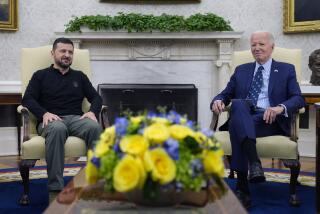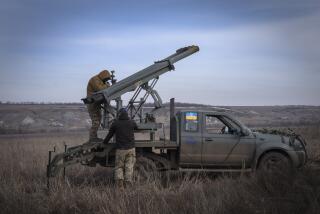Bosnia Muslims, Croats to Get More U.S. Arms
- Share via
SARAJEVO, Bosnia-Herzegovina — The United States will supply Bosnia’s Muslim-Croat Federation with more than 100 heavy-artillery cannons, officials said Friday, dramatically escalating that army’s potential firepower.
The weapons are part of a $100-million train-and-equip program for the Muslim-Croat army, sponsored by Washington and heavily criticized by European allies.
James Pardew, the U.S. diplomat in charge of the program, said at a news conference in the Bosnian capital of Sarajevo that the howitzers will be funded by an extra $15 million that was discovered unexpectedly in the equip-and-train budget.
He said the 116 155-millimeter howitzers will be sent to federation forces, which until now had six. An additional 51 slightly smaller howitzers will be manufactured locally with American help.
European military officers and international peacemakers in Bosnia-Herzegovina said the announcement is sure to anger the Bosnian Serbs, former combatants who are already predicting a new Muslim-Croat offensive this summer.
The military program has drawn criticism from U.S. allies as well as civilian peacekeepers in Bosnia.
They contend that it is a mistake to pour more weapons into a country where memories of war are fresh and where an arms-reduction program, agreed to by all sides as part of the peace process, is not working because Muslim, Serbian and Croatian forces are concealing the true size of their arsenals.
“This runs counter to everything we are trying to do here,” said one official overseeing the 1995 Bosnian peace accords.
But Pardew and other U.S. officials argue that boosting the Muslim-Croat army to put it on par with the Bosnian Serb military is the true guarantor of lasting peace.
“If there is a threat to peace, it’s the Republika Srpska’s failure to comply” with the peace accord, Pardew said, referring to the Bosnian Serb republic that now occupies half of Bosnia. “It is not the U.S. equip-and-train program designed to help the federation defend itself if peace breaks down.”
Pardew said the howitzers are to be delivered by Oct. 15. The Bosnians do not get full custody of any of the weaponry until their U.S. trainers believe that the new army is ready.
The 155-millimeter howitzer has a range of nearly nine miles. It allows troops to maintain distance between themselves and their target.
“This radically changes . . . how you can use your [military] doctrine defensively,” said Joseph Allred, spokesman for the U.S. firm hired to conduct the training in Bosnia.
The equip-and-train program is aimed at bringing together Muslim and Croatian forces, which fought their own ethnic war in 1993, into a single army as a counterweight to the Serbs.
There has been little genuine cooperation between the two, who are nominally joined in the Muslim-Croat Federation controlling half of Bosnia.
Western officials say the Serbs expect to receive new weapons from Russia, while Islamic countries such as Iran and Kuwait have provided military and economic aid to Sarajevo’s Muslim authorities.
Under the peace accords that ended the Bosnian war in December 1995, and in a treaty finalized six months later, all sides agreed to limits on their weaponry and the sizes of their armies.
Any excess is to be destroyed, and older equipment may be replaced with newer and heavier equipment.
Most weaponry is supposed to be stored in warehouses that are routinely inspected by officers of the North Atlantic Treaty Organization.
But the Bosnian Serb and the Muslim-Croat armies are widely believed to be concealing equipment elsewhere and smuggling weapons past the foreign monitors.
NATO officers believe that the Bosnian Serb army has four times the artillery pieces allowed under the peace treaty--and 50% more than it has declared to monitors, according to one analysis. The same report says the federation has nearly three times the allowed number of artillery pieces, less than a tenth of which has been declared.
U.S. officials consider the Bosnian Serbs the greater culprits in the underreporting of materiel, accusing them of having hidden about 2,000 combat vehicles, heavy artillery and other equipment.
*
Although the Bosnians have already received other equipment through the U.S. program, including tanks, the acquisition of heavy-artillery pieces would give the Muslim-Croat army greater power where they most lacked it. The Bosnian Serb army was able to easily capture 70% of Bosnia in the early months of the Bosnian war thanks to its superiority in artillery.
Pardew also announced another controversial element of the equip-and-train program.
He said a new phase of training could begin as early as next month at a center being constructed near the Croat-controlled Bosnian town of Livno.
The center, however, has not yet been approved by NATO, which must sign off on all military activity in Bosnia.
Plans call for the training ground to stretch up to 280 square miles, according to sources familiar with the proposal, in an area once populated by Serbs who were expelled by Croatian forces.
More to Read
Sign up for Essential California
The most important California stories and recommendations in your inbox every morning.
You may occasionally receive promotional content from the Los Angeles Times.













